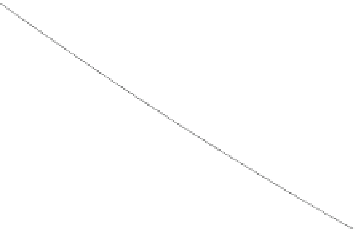Biomedical Engineering Reference
In-Depth Information
1
0.8
0.6
f
0.4
0.2
1
0.8
0
0.6
0
0.2
0.4
x
2
0.4
0.2
0.6
x
1
0.8
0
1
Fig. 4.2
Zhegalkin function
g
Z
=
1
−
x
1
−
x
2
+
2
x
1
x
2
for Boolean function
g
B
=
x
1
x
2
+
x
1
x
2
and the surface conforms to the expected values for the continuous Boolean function
in the unit interval.
In general, given a Boolean function
h
B
, we obtain the corresponding Zhegalkin
function
h
Z
by the following steps:
1. First express
h
B
as a canonical sum of products (or a sum of minterms)
2. For ea
ch
minterm of
h
B
, we write an expression in
h
Z
, by
repla
cing a negative
literal
x
of
h
B
x
). In
g
B
, we have two minterms
x
1
x
2
and
x
1
x
2
. The
corresponding expressions of
g
Z
by (1
−
x
2
) and (
x
1
x
2
) respectively.
3. Expand out and add all the expressions of
h
Z
. For our example, we get
g
Z
are (1
−
x
1
)(1
−
=
(1
−
x
1
)(1
−
x
2
)
+
(
x
1
x
2
)
=
1
−
x
1
−
x
2
+
2
x
1
x
2
4.2.3
Sigmoid Function
The inputs of the Zhegalkin function as used by [
11
] are continuous gene expres-
sion values represented in a linear function. However, actual gene expression is
more complex and depends on several simultaneous and competing factors such
as RNA/protein formation or degradation, chemical reaction rates, and molecular
transport. It has been observed that the expression values tends to saturate at low
and high gene activity and has been suggested that a more accurate representation
of continuous gene expression is a sigmoid function [
14
], [
15
].












































































































